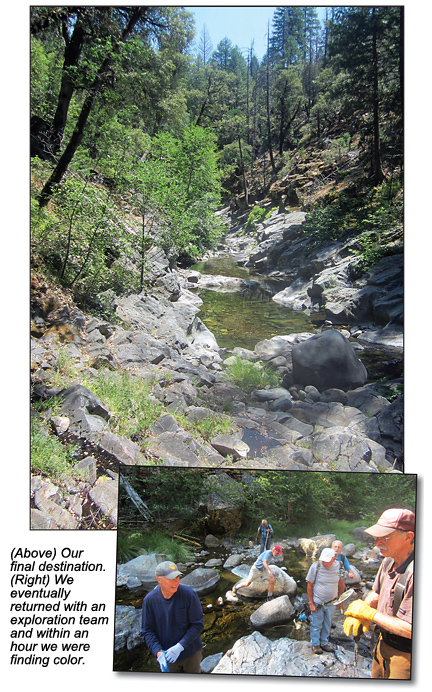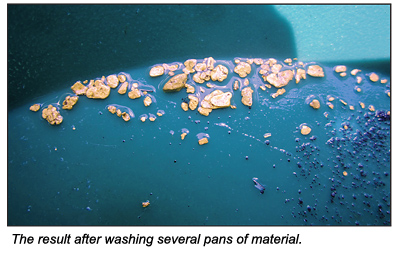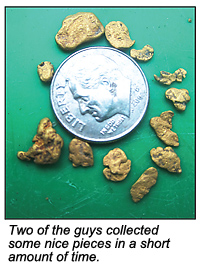Prospecting & Detecting
Free / Prospecting & Detecting
Research and Fieldwork Yield Some Promising Gold
October 2013 by Don
I started prospecting about 35 years ago, and at that time I thought I did a lot of research before going out. Today, I realize I only touched the surface in those years. When I started I believed that there was more gold to be found west of the Mother Lode faulting system than east of it. That’s what many of the books said and it seemed to make sense. The modern-day rivers cut through that vein system, and since the rivers run basically east to west, more gold would be below the vein system than above it. Then I learned that there was an East Belt of the Mother Lode system that was laying down gold east of the main Mother Lode—in some cases, a long way east. This opened up my prospecting options.
Then I learned more about the ancient river channels, where some of them were located, and how they carried gold as well. Where did they get their gold? My exploration area expanded more. It’s kind of like a big forest fire that grows in almost all directions and takes in more and more territory.
 Some of the books I read in my research stated there was hardly any gold from about 4,500 to 5,000 feet, but that theory got knocked out when I opened an old mine for a family at 6,500 feet. We mucked out and re-timbered the mine that headed back into an old channel. We shot it with explosives, increasing the size of the tunnel some. We reached the gravels, then panned some samples. What appeared was a 3-pennyweight, well-worn river nugget. This old buried channel was carrying gold at 6,500 feet! Where did that gold come from? What about the theory that most gold is lower? Wrong again.
Some of the books I read in my research stated there was hardly any gold from about 4,500 to 5,000 feet, but that theory got knocked out when I opened an old mine for a family at 6,500 feet. We mucked out and re-timbered the mine that headed back into an old channel. We shot it with explosives, increasing the size of the tunnel some. We reached the gravels, then panned some samples. What appeared was a 3-pennyweight, well-worn river nugget. This old buried channel was carrying gold at 6,500 feet! Where did that gold come from? What about the theory that most gold is lower? Wrong again.
That led me to more studying about the vein systems in California. I soon realized these old veins went well up into the high country and they were likely feeders of much higher placer gold and hardrock gold too. In past years, I was the superintendent of a hardrock mine near Yosemite that was at an elevation of 5,800 feet and had good gold and paying rock.
I worked in Nevada at a big mine for several years as an assayer. That deposit was at 5,500 feet. Did some of the California gold come from Nevada, too? I was also fortunate to be the vice president at a large open pit placer project involving an old channel at almost 5,000 feet. Where did that placer gold come from?
I realize I know a lot more than I used to about finding gold, and I also realize I have a lot more to learn. Isn’t this fairly true about anything? At first we think we know a lot about a subject and then, as time passes and we learn more, we realize how little we actually knew! After all these years my prospecting has expanded immensely, including 25 years of underground drift mining. There is almost no limit to where and how we look. Research is important, and seeing what and where the old timers worked is a really good start, but it is not the only answer.
Fieldwork is essential and poking around like the old prospectors did in the mid- and late-1800s is still a requirement. One could say that all the areas that are available have already been checked and that we don’t have a chance out there anymore. Well, I can tell you that’s not true. This is basically the reason for this article.
A few months ago I wanted to try finding a new area for some gold prospecting for a two-day outing for a group of prospectors. The purpose was to find a place to pan, sluice and maybe detect some ground that wasn’t worked so much. We all know that’s hard to come by.
I decided to go into the high country well above the old mining towns of Foresthill and Georgetown in California. The area I chose was about 5,400 feet in elevation. One thing that led me to this territory was Lowell Ahart, a long-time reader of ICMJ’s Prospecting and Mining Journal. He was an old timer who read an article I wrote in 2010 and had sent me an e-mail about some of his mining experiences above French Meadows, a lake well up in the mountains. I later found out there was a camp named after him and his brother up there. It’s on the Forest Service maps; they made a campground of his old camp site. This old timer was famous, and still is, in more ways than one. His botany work is well documented and you can look him up on the Internet. Just type in Lowell Ahart.
Lowell gave me specific instructions on where to find the best gold there. A couple of years ago I followed his instructions and found gold just like he said—on the Middle Fork of the American, as it came into the French  Meadows lake. A group of us went there later and found some good placer gold. Thanks, Lowell! I hope you’re still reading! We appreciate your help and the sharing of your mining knowledge.
Meadows lake. A group of us went there later and found some good placer gold. Thanks, Lowell! I hope you’re still reading! We appreciate your help and the sharing of your mining knowledge.
A year later I poked around some more up in that territory, and a couple of us found an old placer channel worked on private ground. Since it was private, and no one was around, we didn’t look at it much, but I didn’t forget it.
With the knowledge of Lowell Ahart’s past work and this old placer not that far away, it led me to look at some of the present day, small mountain streams in that surrounding territory. Surely there would be some ground there that we could go to, without invading someone’s private property or mining claims. One good thing about this high country is that not a lot of prospectors go up there, so there was room for hope.
This was two months ago, and I was just cruising the territory, looking at the old, small streams, getting out of my vehicle and running a pan or two. I saw only one mining claim sign, although you all know that signs get torn down or sometimes are just not posted. Towards the end of the day, I pulled over next to a small stream and ran one pan. I saw color right away—the pieces were small, but rough in nature. A second pan showed the same. I located an old mining claim sign nearby and thought I could get some maps out later and see where this gold was coming from.
The next day I researched the area to determine ownership. I found a mile stretch of this area was on Forest Service land and unclaimed. The maps showed the old private placer works I had seen a few years ago were on the far upstream extension of the creek I was prospecting. That was good news. It seemed to indicate gold was coming down from that area. Maybe the old channel that was worked a mile above had meandered its way down and been cut by this modern-day creek. It was time to go back and drop down into the stream, maybe a half-mile or so above where I panned the color. The area where I had panned was under claim, but not the area above it.
Getting there wasn’t easy. We drove up an old, four-wheel-drive logging road that was pin-striping my Geo Tracker. We came to a likely drop-off point based on the USGS map and the look of the terrain, although we couldn’t see the stream itself. Down we went, and it was fine until we got to the last 50 feet of elevation change, then the terrain dropped sharply. From there it was not fun, but we managed. Within an hour we were finding color, enough to come back with a prospecting team and give this area a going over.
A week later, a small team of us hit it again, and this time the gold really showed up. A half-pennyweight nugget was found, along with many nice, larger gold flakes. By the end of the day we were all excited. Making a long  story short, this stream has now produced lots of nice color and small nuggets. We are just waiting now to have one of us come up with a large, half-ounce piece. I have no doubt it will happen.
story short, this stream has now produced lots of nice color and small nuggets. We are just waiting now to have one of us come up with a large, half-ounce piece. I have no doubt it will happen.
After much more research on the land status, it was discovered that the land was clear of claims and open for mining. Yes, this area is now under a mining claim. No, I am not the one who filed the claim, but our prospecting team can go back anytime without restrictions.
What started out to be a search for an area to pan and a bit of fun turned into a real prospect with good gold and more to follow. The point is there is still good ground out there for us to prospect and to mine appropriately.
The land status of mining claims is also changing rapidly. BLM has increased their recording fees enormously, unless you are a small miner with 10 claims or less and are filing your annual assessment work. The government is making it harder and harder for the miner to exist.
It’s never time to give up. There are many good areas missed, both placer and hardrock. It takes persistence and some good luck, too. Do your research, and sometimes just go venturing out there even if the history doesn’t show anything. The miners might have been there in the olden days when not everything was recorded. 
© ICMJ's Prospecting and Mining Journal, CMJ Inc.